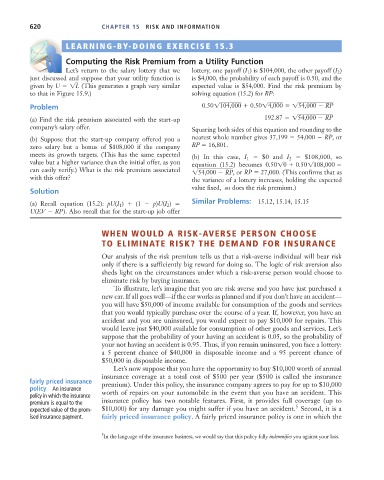Page 646 - Microeconomics, Fourth Edition
P. 646
c15riskandinformation.qxd 8/16/10 11:10 AM Page 620
620 CHAPTER 15 RISK AND INFORMATION
LEARNING-BY-DOING EXERCISE 15.3
S
E D
Computing the Risk Premium from a Utility Function
Let’s return to the salary lottery that we lottery, one payoff (I 1 ) is $104,000, the other payoff (I 2 )
just discussed and suppose that your utility function is is $4,000, the probability of each payoff is 0.50, and the
given by U 1I. (This generates a graph very similar expected value is $54,000. Find the risk premium by
to that in Figure 15.9.) solving equation (15.2) for RP:
Problem 0.501104,000 0.5014,000 154,000 RP
(a) Find the risk premium associated with the start-up 192.87 154,000 RP
company’s salary offer. Squaring both sides of this equation and rounding to the
(b) Suppose that the start-up company offered you a nearest whole number gives 37,199 54,000 RP, or
zero salary but a bonus of $108,000 if the company RP 16,801.
meets its growth targets. (This has the same expected (b) In this case, I 1 $0 and I 2 $108,000, so
value but a higher variance than the initial offer, as you equation (15.2) becomes 0.5010 0.501108,000
can easily verify.) What is the risk premium associated 154,000 RP, or RP 27,000. (This confirms that as
with this offer? the variance of a lottery increases, holding the expected
value fixed, so does the risk premium.)
Solution
Similar Problems: 15.12, 15.14, 15.15
(a) Recall equation (15.2): pU(I 1 ) (1 p)U(I 2 )
U(EV RP). Also recall that for the start-up job offer
WHEN WOULD A RISK-AVERSE PERSON CHOOSE
TO ELIMINATE RISK? THE DEMAND FOR INSURANCE
Our analysis of the risk premium tells us that a risk-averse individual will bear risk
only if there is a sufficiently big reward for doing so. The logic of risk aversion also
sheds light on the circumstances under which a risk-averse person would choose to
eliminate risk by buying insurance.
To illustrate, let’s imagine that you are risk averse and you have just purchased a
new car. If all goes well—if the car works as planned and if you don’t have an accident—
you will have $50,000 of income available for consumption of the goods and services
that you would typically purchase over the course of a year. If, however, you have an
accident and you are uninsured, you would expect to pay $10,000 for repairs. This
would leave just $40,000 available for consumption of other goods and services. Let’s
suppose that the probability of your having an accident is 0.05, so the probability of
your not having an accident is 0.95. Thus, if you remain uninsured, you face a lottery:
a 5 percent chance of $40,000 in disposable income and a 95 percent chance of
$50,000 in disposable income.
Let’s now suppose that you have the opportunity to buy $10,000 worth of annual
insurance coverage at a total cost of $500 per year ($500 is called the insurance
fairly priced insurance premium). Under this policy, the insurance company agrees to pay for up to $10,000
policy An insurance
policy in which the insurance worth of repairs on your automobile in the event that you have an accident. This
premium is equal to the insurance policy has two notable features. First, it provides full coverage (up to
5
expected value of the prom- $10,000) for any damage you might suffer if you have an accident. Second, it is a
ised insurance payment. fairly priced insurance policy. A fairly priced insurance policy is one in which the
5 In the language of the insurance business, we would say that this policy fully indemnifies you against your loss.

